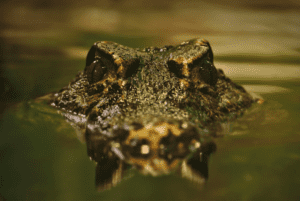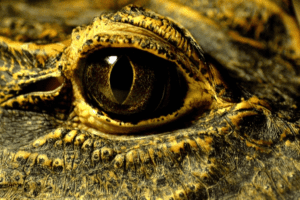Crocodiles are intriguing animals with complex anatomy. But, can they see underwater? Let us find out.
Crocodiles do see underwater, although their vision is quite blurry. Their eyesight is remarkably better on land, and while they are hunting for prey in the water, all other sensory systems need to be active since their vision isn’t sufficient enough to help them actively hunt for prey.
We must add here that crocodiles have a protective membrane(known as a nictitating membrane) that surrounds their eyes when they are underwater. This helps the crocodile see underwater without causing any damage to the surface of their eyeballs.
How far can crocodiles see underwater?
Although crocodiles can see underwater, they are not able to see very far. Allow us to delve further into this discussion.
Crocodiles cannot see very far underwater and may only be able to make out the shape of their potential prey, such as fish, which they then actively hunt. However, crocodiles cannot see as well or as far as humans do. They rely a lot on their other senses when in water to protect themselves from danger.
An interesting ability that crocodiles possess is being able to zoom in and out of objects that interest them. As such, they can easily locate their prey, even from a distance. Thus, even though their eyesight isn’t very strong, they are able to distinguish their prey and prepare for an attack without disturbing it.

Image Credits: “Crocodiles at the Puerto Princesa Crocodile Farm” by Benson Kua is licensed under CC BY-SA 2.0.
Do crocodiles have a blind spot?
Blind spot results in the obscuration of the visual field. All vertebrates tend to have this blind spot. Let us find out whether crocodiles have them too.
Crocodiles have a blindspot just in front of their nose, making it difficult for them to see straight ahead. Even alligators have a blindspot located right before their nose, but both these animals have incredible peripheral vision. However, alligators and crocodiles cannot see what’s right behind them.
Why do crocodiles have eyes located on their sides?

Image Credits: “The eye of the beholder” by v923z is licensed under CC BY 2.0.
You may be curious to know why crocodiles have eyes located on either side. We will tell you all about it.
Crocodiles have eyes placed high above their heads, which gives the onlooker watching from the side the illusion that it is placed on their sides. However, their eyes are uniquely placed to allow them to see above water while swimming and also give them excellent peripheral vision.
In addition, crocodiles also have special receptors that extend across their eyes in a horizontal line (known as a fovea streak) that allows them to scan what is before them without needing to move their eyeballs.
Do all crocodiles have the same vision?
A common question that people have often asked is whether all crocodiles have the same vision and eyesight. Let us learn more in this regard.
Surprisingly, saltwater crocodiles and freshwater crocodiles do not have the same vision. These animals have distinct cone cells (which help them in detecting colors) located in their eyes that adapt to their environment.
While freshwater crocodiles’ eyes are more responsive to red light, having more long-wavelength light, the eyes of saltwater crocodiles are more responsive to blue light, having less long-wavelength light.
Can crocodiles see in the night?
Wondering whether crocodiles can see in the night? Together, we will explore more about this topic.
Crocodiles can easily see at night and have good night vision. This is because they have mirrored receptors that are located at the back of their eyes, and their pupils open completely to accommodate their vision at night which enables them to see well. Even alligators have great night vision.
They can also spot their prey in low-light conditions since they have higher rod density in their retina.
What are the factors involved in a crocodile’s vision underwater?
There are several factors that influence a crocodile’s vision underwater. Let us go through them.
- Crocodiles have microscopic crystals located at the back of their retina, which contain reflective mirrors. These mirrored receptors (or crystal plates) tend to reflect light back at night, allowing the crocodile to see clearly underwater.
- Instead of two, crocodiles tend to have three eyelids which protect them from murky waters and other dangerous places.
- The upper eyelids protect them from attacks and potential dangers, whereas the lower eyelids do not have any prominent function except keeping the third eye in the place.
- The third eyelid of crocodiles is transparent, and it helps them make out shapes of potential prey such as crustaceans and fishes.
- The third eyelid is equipped with a nictitating membrane that forms a thin layer over the crocodile’s eyes and protects its eyes from dust, damage, and potential bites or attacks.
- Crocodiles have retracting eyeballs that allow them to roll back their eyes in their sockets and protect them from any danger if they feel threatened.
All of these factors contribute tremendously to enhancing the overall vision of crocodiles when they are underwater. In addition to helping them see well inside water, the receptors present in their eyes also aid them in recognizing colors.
Do the eyes of crocodiles glow at night?
A common belief is that crocodile eyes glow at night. But is there any truth behind it? Let us find out.
Crocodiles’ eyes glow red if the light is shined on them. This is because crocodile eyes have a structure called tapetum lucidum that acts as a reflector and reflects light back to photoreceptor cells. This improves the animal’s vision and acts as in-built torches at night.
Even alligators have these special reflector cells that glow red at night. These in-built structures enhance the sensitivity of the retina at low-light levels and make the animal’s eyes glow. As such, you can easily spot a crocodile or an alligator in the dark by watching out for bright, glowing eyes.
Alligator eyes vs. crocodile eyes

Image Credits: “crocodile eye / krokodilauge” by Jäger & Sammler is licensed under CC BY-ND 2.0.

Image Credits: “Alligator Eye, NPSphoto, G.Gardner” by evergladesnps is marked with Public Domain Mark 1.0.
There are a few key similarities and differences between alligator and crocodile eyes. Here, we will learn more about them.
| Features | Alligator’s Eyes | Crocodile’s Eyes |
| Location | At the top of their head | At the top of their head |
| Color | Usually dark-brown or yellow (May appear red at night) | Usually yellow or green(May appear bright orange/red at night) |
| Number of Eyelids | Two (Three when submerged) | Three |
| Underwater vision | Can see underwater | Can see underwater |
| Night vision | Can see at night (nocturnal) | Can see at night (nocturnal) |
Needless to say, there are barely any differences between a crocodile and an alligator when it comes to their eyes. They are also quite similar in terms of behavioral patterns. However, these animals are quite different in terms of appearance, lifespan, and so on.
Can crocodiles see in muddy water?
Another common question that often comes up is whether crocodiles have good vision in muddy, murky water. Let us find out.
Crocodiles can see in murky water but their vision becomes blurry and they rely on other senses to help them detect a prey. It is worth mentioning here that a majority of crocodile species live in muddy swamps and murky rivers and as such, their eyes have developed to adapt to their environment.
Conclusion
Being nocturnal animals, crocodiles have eyes that come with vertical pupils. As such, they are able to widen their eyes in the darkness and narrow it in case of excessive brightness, thus controlling the amount of light that enters their eyes. Thus, crocodiles utilize their eyes to the fullest and are able to adequately see above and underwater.
